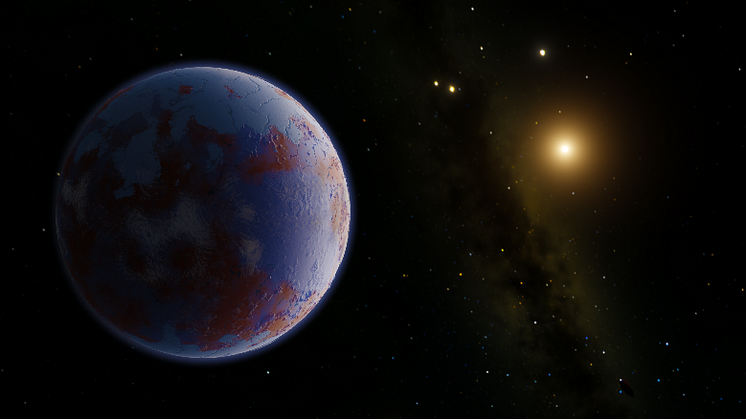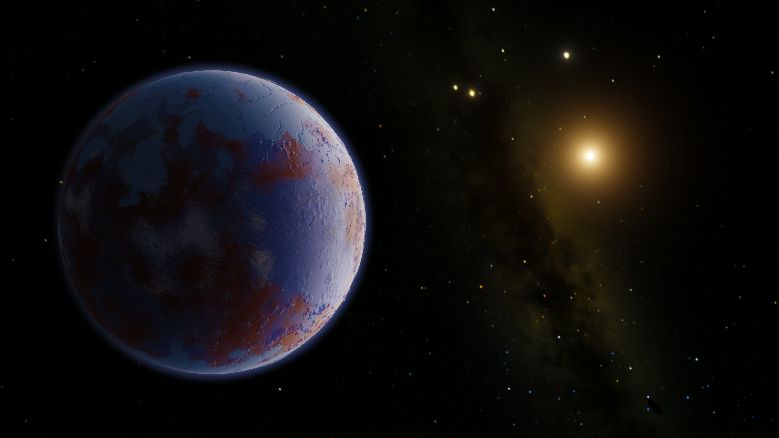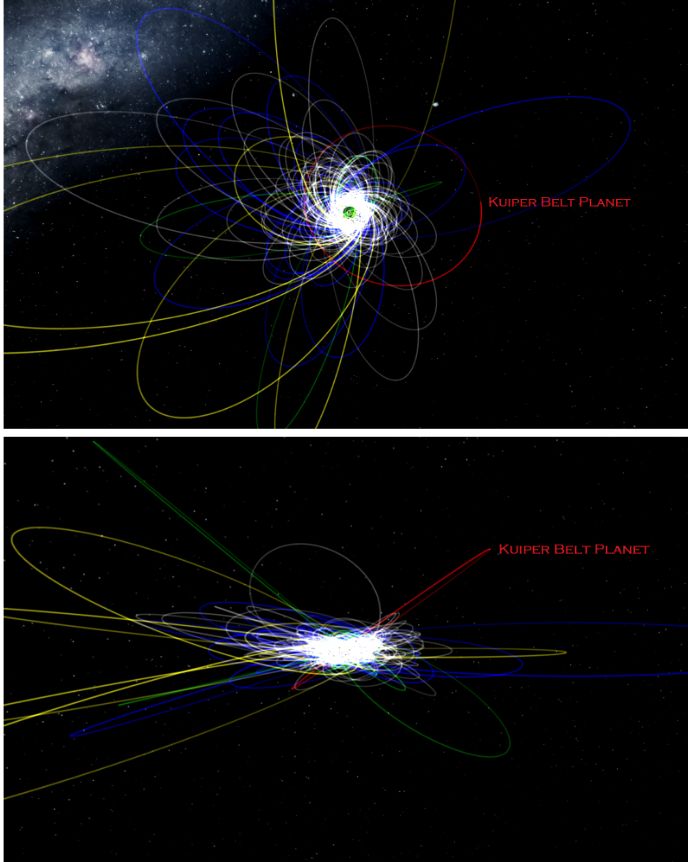
Press release -
Possible Existence of Earth-Like Planet Predicted in the Outskirts of the Solar System -- Kindai University
Osaka [7 September 2023] Researchers from Japan predict, based on computer simulations, the likely existence of an Earth-like planet in the distant Kuiper Belt
There are many unexplained anomalies in the orbits and distribution of trans-Neptunian objects, small celestial bodies located at the outer reaches of the solar system. Now, based on detailed computer simulations of the early outer solar system, researchers from Japan predict the possibility of an undiscovered Earth-like planet beyond Neptune orbiting the Sun. Should this prediction come true, it could revolutionize our understanding of the history of the solar system.
Most people are familiar with the eight known planets of the solar system. However, it is almost certain that billions of years ago from now, the solar system formed more planets than these eight. While most of them have disappeared or left the solar system by now, could it be possible that a few have remained and survive to this day?
The answer to this question may come from what are known as trans-Neptunian objects (TNOs). As the name implies, TNOs are small celestial bodies that orbit the Sun at a greater average distance than the orbit of Neptune. In particular, the distant Kuiper Belt, the region located beyond 7.5 billion kilometers (or 50 astronomical units) from the Sun, contains many TNOs. While these objects represent the remnants of planetary formation in the outer solar system, their orbits and distribution might very well reveal the presence of undiscovered planets.
In a recent study published in The Astronomical Journal on 25 August 2023, Associate Professor Patryk Sofia Lykawka from Kindai University in Japan and Associate Professor (Senior Lecturer) Takashi Ito from the Center for Computational Astrophysics at the National Astronomical Observatory of Japan (CfCA/NAOJ) tackled this puzzle. Based on theoretical analysis of observations coupled with cutting-edge computer simulations, they came to the remarkable conclusion that an Earth-like planet (a planet 1.5–3 times as massive as Earth) may be lurking in the distant Kuiper Belt!
The researchers began by analyzing in detail the orbital structure of the distant Kuiper Belt, which exhibits several unexplained anomalies. For instance, there is a large population of detached TNOs, whose orbits are beyond Neptune’s gravitational influence. Additionally, there is a significant number of TNOs with highly inclined orbits along with a population of “extreme TNOs” whose orbits are extremely difficult to explain with the current models for the formation of the solar system and the Kuiper Belt.
Based on these analyses, the researchers theorized that another planet besides the four giants (Jupiter, Saturn, Uranus, and Neptune) must have influenced the formation of the Kuiper Belt. To test their hypothesis, they conducted a multitude of computer simulations using the research computers installed in Lykawka’s laboratory and the general-purpose PC cluster at NAOJ, using models of the early solar system that existed about 4.5 billion years ago. Herein, the researchers considered interactions between the four giant planets, a hypothetical Kuiper Belt planet, and a disk of small objects representing the primordial distant Kuiper Belt. After each simulation was completed, the resulting populations of TNOs following the lapse of 4.5 billion years were compared to those gathered from modern observations to see if any of the models explained the anomalies in the distant Kuiper Belt.
Remarkably, the simulation's best results suggested that there should be an undiscovered planet with a mass 1.5–3 times that of the Earth orbiting the Sun at distances between about 200 and 500 (or even ~200–800) astronomical units. Thanks to the palpable mass and an inclined orbit of about 30°, such a planet could have generated the large number of detached TNOs, the highly inclined TNOs, as well as the extreme TNOs with peculiar orbits, in line with our current observations.
The discovery of a new Earth-like planet in the solar system would no doubt have profound implications, as Dr. Lykawka explains: “First, the solar system would officially have nine planets again. Moreover, much like what happened in 2006 when Pluto was demoted from the planet category, we would need to refine the definition of a ‘planet,’ since an Earth-like planet located far beyond Neptune would likely belong to a new class of planets. Finally, our theories of solar system and planet formation would also need revision.”
Now that the prediction has been made, it is time to search for this Earth-like planet in the distant Kuiper Belt. According to Dr. Lykawka, future Japanese or international astronomical surveys might be able to detect this new planet in less than a decade. Many new extreme TNOs could be discovered in the process, providing valuable insights into the trans-Neptunian region. “A more detailed knowledge of the orbital structure in the distant Kuiper Belt will provide us with a better understanding of the formation of the outer solar system, which would also reveal the conditions under which the planets formed. Even the discovery of a single or a few such new TNOs could revolutionize our theories about how the solar system formed.”
We too hope that future research efforts will unveil some long-hidden secrets of the solar system!
Reference
Title of original paper:
Is There an Earth-like Planet in the Distant Kuiper Belt?
Journal:
The Astronomical Journal
DOI:
10.3847/1538-3881/aceaf0
URL:
https://iopscience.iop.org/article/10.3847/1538-3881/aceaf0
IMAGE INFORMATION

Image Title:
An Earth-like planet in the far reaches of the solar system (artistic illustration).
Image Caption:
Computer simulations suggest that there is an undiscovered Earth-like planet lurking in the distant Kuiper Belt, well past the orbit of Neptune.
Image Credit:
Fernando Peña D’Andrea
License Type:
Original Content
Usage Restrictions:
This image may be reused if credit is given to the author, but not for commercial purposes.

Image Title:
Possible orbit of the newly predicted planet.
Image Caption:
The orbit of the undiscovered Earth-like planet is predicted to be eccentric with an inclination of about 30°.
Image Credit:
Patryk Sofia Lykawka
License Type:
Original Content
Usage Restrictions:
This image may be reused if credit is given to the author, but not for commercial purposes.

Image Title:
Simulating the early outer solar system with the general-purpose PC cluster operated at Center for Computational Astrophysics (CfCA), the National Astronomical Observatory of Japan (NAOJ).
Image Caption:
Numerical simulations presented in this work were in part performed using the general-purpose PC cluster operated at CfCA, NAOJ.
Image Credit:
NAOJ
License Type:
Original Content
Usage Restrictions:
This image may be reused after giving appropriate credit, but within the scope of free use granted under Japanese copyright law: for the purposes of private use, educational use, news reporting, etc.
About Kindai University
Kindai University was established in 1949 after the merger of Osaka Technical College (founded in 1925) and Osaka Science and Engineering University (founded in 1943). Over the past several decades, the university has transformed into a comprehensive educational organization with an ever-growing reputation. Kindai University has over 2,200 full-time faculty members, 6 campuses, and 18 research centers. As an academic institution offering a broad range of programs from across disciplines, Kindai University strives to impart practical education while nurturing intellectual and emotional capabilities. The university’s academic programs are fully accredited by Japan’s Ministry of Education, Culture, Sports, Science and Technology as well as by the National Institution for Academic Degrees and University Evaluation.
Website: https://www.kindai.ac.jp/english/
About Associate Professor Patryk Sofia Lykawka from Kindai University
Patryk Sofia Lykawka obtained his Ph.D. degree in Earth and Planetary System Sciences from Kobe University, Japan, in 2007. He joined Kindai University as an Assistant Professor in 2009 and became an Associate Professor in 2015. His research interests include the origin and evolution of the solar system, the Kuiper Belt, terrestrial planet formation, asteroids, trans-Neptunian objects, and other small bodies in the solar system. He has authored more than 80 papers on these topics, which have received over 1,500 citations according to Google Scholar. He is also a member of the International Astronomical Union, the Astronomical Society of Japan, The Japanese Society for Planetary Sciences, the Japan Geoscience Union, and the Division for Planetary Sciences of the American Astronomical Society. An asteroid was named (10018) Lykawka by the International Astronomical Union to honor his research in 2017.
Funding information
This work was supported by JSPS KAKENHI Grant Number JP20K04049.




